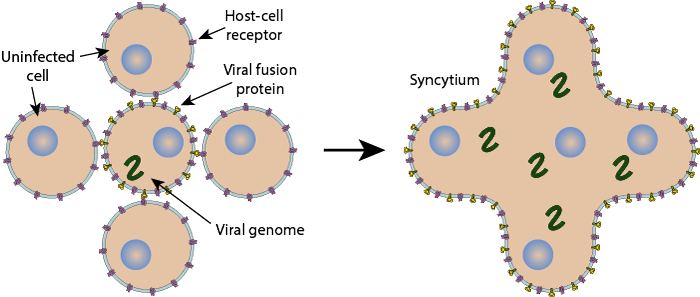
Syncytium formation induced by viral infection (kw:KW-1180)
Fusion from without directed by human immunodeficiency virus particles
F. Clavel, P. Charneau
J. Virol. February 1994; 68: 1179?1185
F. Clavel, P. Charneau
J. Virol. February 1994; 68: 1179?1185
Fusion of intra- and extracellular forms of vaccinia virus with the cell membrane
R. W. Doms, R. Blumenthal, B. Moss
J. Virol. October 1990; 64: 4884?4892
R. W. Doms, R. Blumenthal, B. Moss
J. Virol. October 1990; 64: 4884?4892
Membrane fusion mediated by herpesvirus glycoproteins: the paradigm of varicella-zoster virus
Nancy L. Cole, Charles Grose
Rev. Med. Virol. August 2003; 13: 207?222
Nancy L. Cole, Charles Grose
Rev. Med. Virol. August 2003; 13: 207?222
Glycoprotein interactions in paramyxovirus fusion
Ronald M. Iorio, Vanessa R. Melanson, Paul J. Mahon
Future Virol July 1, 2009; 4: 335?351
Ronald M. Iorio, Vanessa R. Melanson, Paul J. Mahon
Future Virol July 1, 2009; 4: 335?351
Characterization of cell-cell fusion mediated by herpes simplex virus 2 glycoproteins gB, gD, gH and gL in transfected cells
M. I. Muggeridge
J. Gen. Virol. August 2000; 81: 2017?2027
M. I. Muggeridge
J. Gen. Virol. August 2000; 81: 2017?2027
Reovirus FAST proteins: virus-encoded cellular fusogens
Marta Ciechonska, Roy Duncan
Trends Microbiol. December 2014; 22: 715?724
Marta Ciechonska, Roy Duncan
Trends Microbiol. December 2014; 22: 715?724
Matching UniProtKB/Swiss-Prot entries
(all links/actions below point to uniprot.org website)21 entries grouped by strain
1 entry
Bovine respiratory syncytial virus (strain A51908) (BRS) reference strain
1 entry
Equine herpesvirus 1 (strain Ab4p) (EHV-1) (Equine abortion virus) reference strain
1 entry
Gallid herpesvirus 2 (strain Chicken/Md5/ATCC VR-987) (GaHV-2) (Marek's disease herpesvirus type 1) reference strain
1 entry
Human herpesvirus 1 (strain 17) (HHV-1) (Human herpes simplex virus 1) reference strain
1 entry
Human herpesvirus 2 (strain HG52) (HHV-2) (Human herpes simplex virus 2) reference strain
1 entry
Human respiratory syncytial virus B (strain B1) reference strain
1 entry
Psittacid herpesvirus 1 (isolate Amazon parrot/-/97-0001/1997) (PsHV-1) (Pacheco's disease virus) reference strain
1 entry
Varicella-zoster virus (strain Dumas) (HHV-3) (Human herpesvirus 3) reference strain
1 entry
Bovine respiratory syncytial virus (strain Copenhagen) (BRS)
1 entry
Bovine respiratory syncytial virus (strain Rb94) (BRS)
1 entry
Equine herpesvirus 1 (strain Kentucky A) (EHV-1) (Equine abortion virus)
1 entry
Human herpesvirus 1 (strain KOS) (HHV-1) (Human herpes simplex virus 1)
1 entry
Human herpesvirus 1 (strain MP) (HHV-1) (Human herpes simplex virus 1)
1 entry
Human herpesvirus 1 (strain R15) (HHV-1) (Human herpes simplex virus 1)
1 entry
Human herpesvirus 1 (strain R19) (HHV-1) (Human herpes simplex virus 1)
1 entry
Human respiratory syncytial virus
1 entry
Human respiratory syncytial virus A (strain A2)
1 entry
Human respiratory syncytial virus A (strain RSS-2)
1 entry
Human respiratory syncytial virus B (strain 18537)
1 entry
Suid herpesvirus 1 (strain Kaplan) (SuHV-1) (Pseudorabies virus (strain Kaplan))
1 entry

